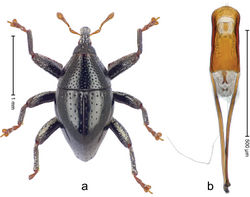Trigonopterus yorkensis
| Notice: | This page is derived from the original publication listed below, whose author(s) should always be credited. Further contributors may edit and improve the content of this page and, consequently, need to be credited as well (see page history). Any assessment of factual correctness requires a careful review of the original article as well as of subsequent contributions.
If you are uncertain whether your planned contribution is correct or not, we suggest that you use the associated discussion page instead of editing the page directly. This page should be cited as follows (rationale):
Citation formats to copy and paste
BibTeX: @article{Riedel2016ZooKeys, RIS/ Endnote: TY - JOUR Wikipedia/ Citizendium: <ref name="Riedel2016ZooKeys">{{Citation See also the citation download page at the journal. |
Ordo: Coleoptera
Familia: Curculionidae
Genus: Trigonopterus
Name
Trigonopterus yorkensis Riedel sp. n. – Wikispecies link – ZooBank link – Pensoft Profile
Diagnostic description
Holotype (Fig. 32a). Length 1.84 mm. Color black, antenna and tarsi ferruginous. Body subrhomboid, without constriction between pronotum and elytron; in profile evenly convex. Rostrum punctate-rugose, with sparse white scales, median ridge indistinct. Eyes large, in subdorsal position. Forehead punctate, with scattered brown scales. Pronotum coarsely punctate, interspaces between punctures polished; with sparse narrow brown scales inserting in punctures. Elytra subglabrous; striae marked by indistinct rows of minute punctures each containing minute narrow brown scale; at apical margin with few white almond-shaped scales. Legs. Femora dorsally clothed with white scales; anteroventral furrow with sparse row of white scales. Profemur with anteroventral ridge basally abruptly ending forming blunt angle; with somewhat indistinct subbasal callus. Tibial apex with uncus, without premucro. Abdominal ventrites 1-2 laterally swollen, medially concave; ventrite 5 coarsely punctate, at middle concave. Penis (Fig. 32b) with sides of body subparallel to subangulate apex; transfer apparatus simple, elongate, with pair of small basal sclerites; ductus ejaculatorius without bulbus. Intraspecific variation. Length 1.70–1.96 mm. Female rostrum with sparse small punctures, with sparse recumbent setae, only basally with few scales. Female abdominal ventrites 1-2 medially flat; ventrite 5 flat.
Material examined
Male, holotype (QMBA): ARC3707 (EMBL # LN888189), Queensland, W Bloomfield, Mt. Misery, S15°52.706', E145°13.383',750-850 m, 30-IV-2014. Paratypes (QMBA, SMNK): Queensland: 5 exx, ARC3706 (EMBL # LN888188), ARC3708 (EMBL # LN888190), ARC3709 (EMBL # LN888191), same data as holotype; 1 ex, Mt. Misery, summit, 15°52', S 145°14', E, 850 m, 03-I-1991, Pyrethrum knockdown; 1 ex, Massey Ra., 6 km NW of Bellenden Kerr, 17°14', S 145°48', E, 1150 m, 11-X-1991.
Distribution
Queensland: Mt. Misery, Massey Range.
Biology
Beaten from foliage in relatively dry forest.
Etymology
This epithet is an adjective based on the Cape York Peninsula, where the type locality is located.
Notes
Trigonopterus yorkensis Riedel, sp. n. was coded as “Trigonopterus sp. 552”.
Original Description
- Riedel, A; Tänzler, R; 2016: Revision of the Australian species of the weevil genus Trigonopterus Fauvel ZooKeys, (556): 97-162. doi
Images
|
